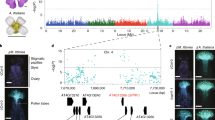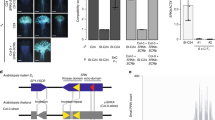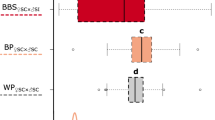Abstract
In many flowering plant species, a system of self-incompatibility, typically controlled by a single gene with multiple alleles (S-gene)1, enables individual plants to recognize and reject their own pollen. In gametophytically determined systems, the growth of self-pollen tubes is arrested in the style or occasionally the ovary. The expression of this self-incompatibility is developmentally regulated, being strongest in mature flowers and weak in immature styles1,2. We have used a complementary DNA clone, believed to encode the S2-allele of Nicotiana alata2,3, to detect S2 messenger RNA by in situ hybridization to sections. We report here that expression of the gene occurs in the stigma and throughout the secretory tissue, but not in other parts, of mature pistils. In immature flowers, S2 mRNA is confined to the proliferated epidermis of the stigma. We conclude that S2-gene expression correlates well with the expression of incompatibility.
This is a preview of subscription content, access via your institution
Access options
Subscribe to this journal
Receive 51 print issues and online access
$199.00 per year
only $3.90 per issue
Buy this article
- Purchase on Springer Link
- Instant access to full article PDF
Prices may be subject to local taxes which are calculated during checkout
Similar content being viewed by others
References
De Nettancourt, D. in Incompatibility in Angiosperms (Springer, Berlin, 1977).
Anderson, M. A. et al. Nature 321, 38–44 (1985).
Bredemeijer, G. M. & Blaas, J. Theor. appl Genet. 59, 185–190 (1981).
Satina, S. Am. J. Bot. 31, 493–502 (1944).
Mau, S-L. et al. Planta 169, 184–191 (1986).
Satina, S. & Blakeslee, A. F. Am. J. Bot. 30, 395–450 (1943).
Corner, E. J. H. J. Linn. Soc. (Bot.) 56, 33–40 (1958).
Brewbaker, J. L. & Gorrez, D. D. Am. J. Bot. 54, 611–616 (1967).
Coghlan, J. P., Penschow, J. D., Hudson, P. J. & Niall, H. D. Clin. Exper. Hyper. Theory and Practice A6 (1&2), 63–78 (1984).
Feinberg, A. P. & Vogelstein, B. Analyt. Biochem. 132, 6–13 (1983).
Hafen, E., Levine, H., Garber, R. L. & Gehring, W. J. EMBO J. 2, 617–623 (1983).
Maniatis, T., Fritsch, E. F. & Sambrook, J. Molecular Cloning; A Laboratory Manual (Cold Spring Harbor Laboratory, New York, 1982).
Fincher, G. B. et al. Proc. natn. Acad. Sci. U.S.A. 83, 2081–2085 (1986).
Bade, A., Harris, P. J. & Stone, B. A. in The Biochemistry of Plants Vol. 12 (ed. Preiss, J.) (Academic, New York, in the press).
Author information
Authors and Affiliations
Rights and permissions
About this article
Cite this article
Cornish, E., Pettitt, J., Bonig, I. et al. Developmentally controlled expression of a gene associated with self-incompatibility in Nicotiana alata. Nature 326, 99–102 (1987). https://doi.org/10.1038/326099a0
Received:
Accepted:
Published:
Issue Date:
DOI: https://doi.org/10.1038/326099a0
This article is cited by
-
Flower Senescence-Strategies and Some Associated Events
The Botanical Review (2011)
-
Structure of styles and pollen tubes of distylous Turnera joelii and T. scabra (Turneraceae): are there different mechanisms of incompatibility between the morphs?
Sexual Plant Reproduction (2010)
-
Compartmentalization of S-RNase and HT-B degradation in self-incompatible Nicotiana
Nature (2006)
-
An S-RNase promoter from Nicotiana alata functions in transgenic N. alata plants but not Nicotiana tabacum
Plant Molecular Biology (1995)
Comments
By submitting a comment you agree to abide by our Terms and Community Guidelines. If you find something abusive or that does not comply with our terms or guidelines please flag it as inappropriate.



